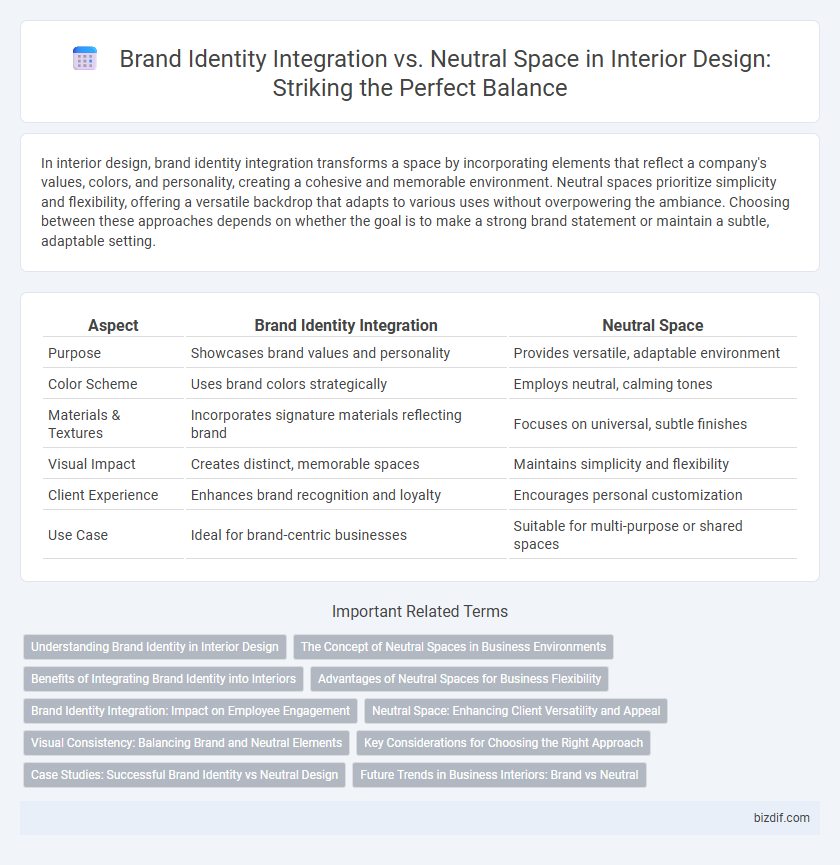In interior design, brand identity integration transforms a space by incorporating elements that reflect a company's values, colors, and personality, creating a cohesive and memorable environment. Neutral spaces prioritize simplicity and flexibility, offering a versatile backdrop that adapts to various uses without overpowering the ambiance. Choosing between these approaches depends on whether the goal is to make a strong brand statement or maintain a subtle, adaptable setting.
Table of Comparison
| Aspect | Brand Identity Integration | Neutral Space |
|---|---|---|
| Purpose | Showcases brand values and personality | Provides versatile, adaptable environment |
| Color Scheme | Uses brand colors strategically | Employs neutral, calming tones |
| Materials & Textures | Incorporates signature materials reflecting brand | Focuses on universal, subtle finishes |
| Visual Impact | Creates distinct, memorable spaces | Maintains simplicity and flexibility |
| Client Experience | Enhances brand recognition and loyalty | Encourages personal customization |
| Use Case | Ideal for brand-centric businesses | Suitable for multi-purpose or shared spaces |
Understanding Brand Identity in Interior Design
Understanding brand identity in interior design involves translating a company's values, mission, and personality into spatial elements that enhance customer experience and reinforce brand recognition. Brand identity integration uses colors, textures, and layouts reflective of the brand's ethos, creating a cohesive environment that communicates distinctiveness and fosters emotional connections. In contrast, neutral spaces prioritize versatility and inclusiveness, offering a blank canvas that minimizes brand imprint to focus on functionality and adaptability for broader audiences.
The Concept of Neutral Spaces in Business Environments
Neutral spaces in business environments serve as versatile backdrops that enhance functionality and focus without overwhelming brand messaging. These spaces utilize muted color palettes, minimalistic furnishings, and balanced lighting to create calming atmospheres that foster productivity and flexibility. By avoiding strong brand elements, neutral designs support diverse uses and occupant customization while maintaining a professional and timeless aesthetic.
Benefits of Integrating Brand Identity into Interiors
Integrating brand identity into interior design enhances customer experience by creating a cohesive and memorable atmosphere that reflects the company's values and personality. It boosts brand recognition and loyalty through consistent use of logos, colors, and thematic elements, making the space instantly identifiable. This strategic approach also fosters employee engagement and pride by embedding the brand culture into everyday work environments.
Advantages of Neutral Spaces for Business Flexibility
Neutral spaces in interior design offer unmatched business flexibility by providing a versatile backdrop that easily adapts to evolving brand identities and seasonal changes. Such environments reduce redesign costs and allow seamless incorporation of temporary elements, ensuring spaces remain relevant without extensive overhauls. The minimalistic palette and unobtrusive aesthetics facilitate diverse functional uses, from client meetings to product launches, enhancing operational efficiency.
Brand Identity Integration: Impact on Employee Engagement
Brand Identity Integration in interior design significantly enhances employee engagement by creating an environment that reflects company values and culture, fostering a sense of belonging and pride. Incorporating branded elements such as color schemes, logos, and mission-driven artwork can boost motivation, creativity, and collaboration among staff. Research indicates that aligned brand environments reduce turnover rates and improve overall workplace satisfaction.
Neutral Space: Enhancing Client Versatility and Appeal
Neutral space in interior design offers a versatile foundation that enhances client appeal by allowing personalized customization and adaptability across diverse styles. Incorporating neutral tones and minimalistic elements creates a balanced environment that highlights brand identity without overpowering it. This strategic use of neutral space fosters a welcoming atmosphere that supports multiple functions while maintaining aesthetic coherence.
Visual Consistency: Balancing Brand and Neutral Elements
Visual consistency in interior design demands a strategic blend of brand identity integration and neutral space to create environments that are both memorable and versatile. Incorporating branded colors, logos, and thematic elements ensures cohesive representation, while neutral tones and minimalist furnishings prevent visual overload and maintain flexibility. Achieving this balance enhances user experience and reinforces brand recognition without compromising spatial harmony.
Key Considerations for Choosing the Right Approach
Brand identity integration in interior design emphasizes incorporating logos, color schemes, and signature elements to create a cohesive and memorable environment that reinforces brand recognition. Neutral spaces prioritize versatility and timelessness by using understated colors and minimal branding, allowing for flexibility and prolonged relevance. Key considerations include the target audience's expectations, brand personality, and the functional purpose of the space to balance aesthetic impact with user experience.
Case Studies: Successful Brand Identity vs Neutral Design
Case studies in interior design reveal that successful brand identity integration enhances customer engagement and reinforces brand recognition through consistent use of colors, logos, and thematic elements. Neutral space designs, while versatile and calming, often lack distinctiveness, making it challenging for brands to leave a lasting impression. Brands like Apple demonstrate effective identity integration by merging sleek, minimalistic elements with signature design cues, contrasting with generic neutral interiors that offer functionality but limited brand storytelling.
Future Trends in Business Interiors: Brand vs Neutral
Emerging trends in business interiors emphasize strategic brand identity integration through customized color schemes, logos, and thematic elements that enhance corporate culture and client recognition. Contrastingly, neutral spaces prioritize flexibility and timeless appeal, facilitating adaptable uses and broad occupant comfort. Advancements in digital displays and smart materials are enabling seamless transitions between branded environments and neutral backdrops, supporting dynamic business needs and evolving workplace strategies.
Brand Identity Integration vs Neutral Space Infographic

 bizdif.com
bizdif.com